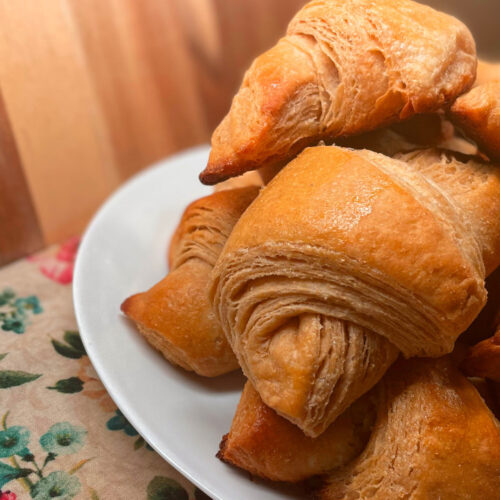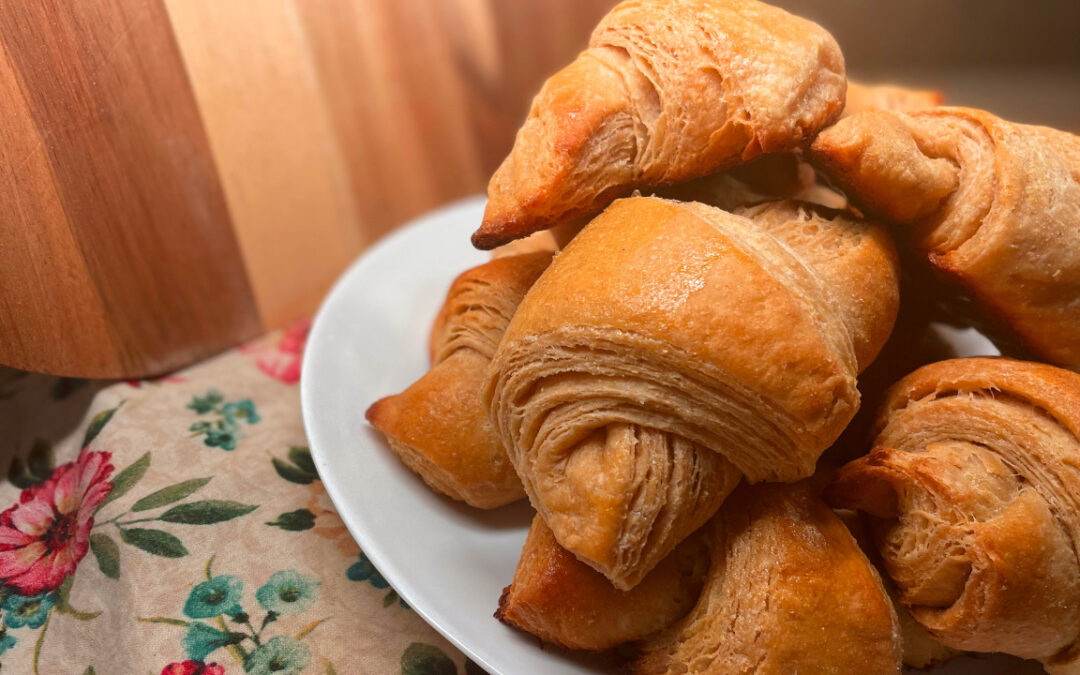Welcome to the FINAL recipe of the #makebread365 challenge for 2023!! We made it!!
If you haven’t been keeping up with the challenge, you can catch up by seeing our past recipes here!
Croissants can seem DAUNTING and quite intimidating. But the process isn’t actually difficult, it is just detailed and takes a lot of preparation!
The results are worth it though because you have never really tasted a croissant until you have tasted one made from freshly milled wheat!
I do HIGHLY recommend watching the video to fully understand the recipe directions!
As always, ENJOY!
(P.S. This recipe is a converted recipe from the wonderful Sally’s Baking Addiction!)

Croissants with 100% Freshly Milled Wheat
This is a recipe conversion from Sally's Baking Addiction! All made with 100% freshly milled wheat.
Equipment
- 1 Grain Mill
- 1 mixer the Nutrimill Artiste was used in this video!
Ingredients
Ingredients for dough
- 1/4 cup unsalted butter softened to room temperature
- 4 cups freshly milled hard white wheat flour Mill 4 cups of hard white wheat berries. This will be enough for 4 cups of flour plus more for dusting and butter layer.
- 1/4 cup sugar I prefer cane sugar
- 2 tsp salt
- 1 TB instant yeast
- 1 1/2 cups cold whole milk
Butter Layer
- 1 1/2 cups unsalted butter softened to room temperature
- 2 TB freshly milled hard white wheat flour use the flour you milled for the dough
Egg Wash
- 1 large egg
- 2 TB whole milk
Instructions
- Combine 4 cups freshly milled hard white wheat flour, sugar, salt, and yeast into stand mixer. Mix to gently combine with dough hook attachment.
- Cut butter into 4 tablespoons and place throughout dry mixture. Turn mixer onto low with dough hook attachment and mix ingredients together for 1 minute.
- After 1 minute, with mixer on lowest setting, add half of the cold milk. Allow it to mix into dough. Once mixed in, add rest of milk.
- Once all milk is added, the dough has probably come together and off the sides of the bowl. Turn mixer onto medium speed and knead for a total of five minute.
- Halfway through kneading, check the dough. At this point, if dough is now sticking to the sides of the mixing bowl, start adding very small amounts of flour at a time. Add 1 TB, let it incorporate, then add another one if needed. You are looking for the dough to JUST start pulling away from the sides of the bowl. Once dough just starts to pull away from the sides of the bowl, stop adding flour. Continue to let it knead for the rest of the time. By the end of the 5 minutes, the dough should be coming together into more of a ball and off the sides of the bowl (see video for visual).
- After kneading, dough will be slightly tacky. It will pull apart. This is normal. There is plenty of resting time for the gluten to relax. It will not feel like normal bread dough. This feels a bit closer to soft play-dough and not as smooth and soft as normal yeast bread doughs.
- After kneading, remove dough from bowl and place on a silicone baking mat, parchment paper, or silicone pastry mat (like the one in the video). Shape into a ball, cover with plastic wrap, place in fridge for 30 minutes.
- After 30 minutes, remove dough from fridge. On lightly floured surface (I prefer to do this on the pastry mat as seen in video so dough is easily transferable), roll out dough into a 14x10 rectangle. It is important to form a rectangle, not an oval and that you measurement is accurate! The dough will still feel like play-dough. This is normal.
- Once dough as been rolled out into rectangle, cover with plastic wrap, place on baking sheet and put back in refrigerator. Allow to rest for 4 hours, overnight, or up to 24 hours.
- BUTTER LAYER: 35 minutes before you are ready to remove dough from fridge, combine the 1 1/2 cups of butter and 2 TB freshly milled hard white wheat flour and beat together until it's combined and smooth.
- On the wrong side of parchment paper, draw out a 7x10 rectangle. Flip parchment paper over and spread out butter mixture to form a 7x10 butter rectangle. Be precise.
- Once butter is in 7x10 rectangle, place in fridge for 30 minutes (any more than this and butter may be too hard to roll out later). If you do need your butter layer to be in fridge longer, just pull out from fridge and allow to gently soften on counter so you can roll it out in the next step.
Lamination & 1st Turn
- Remove dough and butter layer from fridge.
- Place butter layer in the center of the dough layer. Fold over each side of dough onto the butter layer and seal all edges.
- On a lightly floured surface, roll out dough into a 10x20 inch rectangle. It is easier to roll out the dough to get the correct width first, then roll out to get the full length. See video for details.
- Make sure you are forming a rectangle and not an oval. Keep measuring the dough and be precise!
- Once dough has been rolled out into a 10x20 inch rectangle, Start on one of the short ends and fold over 1/3 of dough. Then go to the other short end and fold over on top of the previous 1/3 of dough. This is like folding a letter (See video).
2nd Turn
- Turn the dough and, again, roll out dough to a 10x20 inch rectangle.
- Once dough has been rolled out to correct measurements, fold the dough as you did previously in thirds like you would fold a letter.
- Cover dough with plastic wrap and place in fridge for 30 minutes. This allows the dough to rest and for the butter layer to firm up a little bit after all of the rolling.
3rd Turn
- After 30 minutes, remove dough from fridge. Roll into 10x20 inch rectangle. Fold lengthwise into thirds like you are folding a letter.
- Cover with plastic wrap and place in fridge to rest for 4 hours, overnight, or up to 24 hours.
Shaping
- After long rest, remove dough from fridge. It will have risen while in the fridge and not be as soft as before due to it being cold.
- Roll out dough into 8x20 rectangle. This will be harder to roll out than before due to the dough being cold. Make sure your measurements are accurate and the dough is in a rectangle and not an oval.
- Once dough has been rolled out, cut dough in half vertically with pizza cutter or sharp knife. I like to mark both ends first then cut with pizza cutter.
- After dough has been cut lengthwise, Cut 3 even slices horizontally (I measure every 5 inches on the long side). You will end up with eight 4x5 inch rectangles.
- Cut each rectangle in half on the diagonal to get 16 triangles.
- Work with one triangle at a time. Gently roll out with rolling pin to about 8 inches long. Then cut a small slit at the top of the triangle and roll into a crescent shape. Smooth the tip into the dough to seal. Place on baking sheet with seam side down.
- Form the rest of the croissants.
- Cover with plastic wrap or light tea towel and allow to rest and rise at room temperature for 1 hour.
- At this point, you can freeze the croissants, place them in fridge to bake up to 12 hours later, or bake them.
- When ready to bake, preheat oven to 400 degrees F. Make egg wash and brush egg wash over croissants.
- Bake croissants until golden brown. Takes about 20 minutes. Rotate baking trays about halfway through to ensure even baking. If croissants are darkening too fast, lower heat to 375 degrees F.
- When baked, remove croissants from oven and allow to cool on wire rack for a few minutes.
- Serve them up and ENJOY!
Notes
Make Ahead:
Croissants are best when eaten the day they are baked. Plan accordingly!
You can freeze the dough after the final turn. Just wrap dough tightly in plastic wrap or tin foil and place in freezer zipped-top bag. Freeze up to 3 months. Thaw in refrigerator and continue on with the steps.
If you want to freeze croissants do so when they have been shaped, but not baked. Tightly wrap up croissants and freeze up to 1 month. Thaw completely in refrigerator then bake as directed.
Nutrition
Calories: 5042kcalCarbohydrates: 426gProtein: 90gFat: 352gSaturated Fat: 215gPolyunsaturated Fat: 19gMonounsaturated Fat: 90gTrans Fat: 13gCholesterol: 1088mgSodium: 4929mgPotassium: 2592mgFiber: 54gSugar: 71gVitamin A: 10883IUVitamin C: 0.01mgCalcium: 783mgIron: 19mg
Tried this recipe?Let us know how it was!



Hi Felicia I make croissants every year for christmas I usually use king arthur high gluten flour because of the protein content I have been milling my own flour for a while I was thinking could I use freshly milled flour in combination with the high gluten flour ? I also make my dough and butter layer and refrigerate both overnight before I do my turns the next day .thanks for the video it was informative.
You possibly could, but I do not know. I have never tried it, only 100% freshly milled wheat.